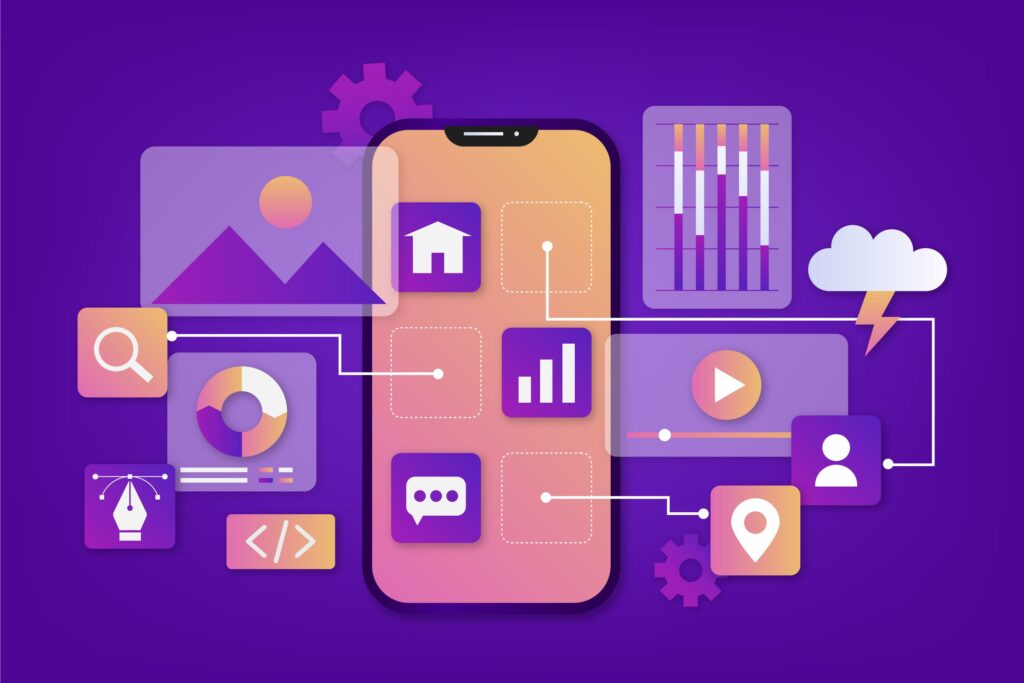Importance Of Best Practices for Low-Code Application Development
It is important to look for the Best Practices for Low-Code Application Development. Low-code application development is a technique for rapidly creating software applications with minimal hand-coding, utilizing visual interfaces and pre-existing components. This approach empowers both technical and non-technical users to develop applications, thereby speeding up the development process and lessening the reliance on traditional coding skills.

While low-code platforms enhance efficiency, adhering to best practices is essential for creating secure, scalable, and maintainable applications.
Understand Your Platform:
One of the most appealing aspects of low-code and no-code development is that it requires minimal effort to get started. This accessibility is indeed a significant advantage, but it can also be somewhat misleading. While low-code development empowers various departments within your organization to create applications, it still necessitates a degree of technical knowledge that is not required with no-code platforms. You don’t need to be an expert coder, but having a solid understanding of the fundamentals of the platform you choose will greatly enhance your chances of successfully developing a functional application.
To maximize the benefits of low-code development, it is essential for everyone on your team—especially product managers and business analysts—to invest time in learning about the platform’s capabilities. This includes experimenting with aspects such as platform integration, API creation, and user interface (UI) design.
By doing so, team members can better understand how to leverage the platform’s features effectively. Moreover, fostering a culture of continuous learning and experimentation will not only improve individual skills but also enhance overall team collaboration, leading to more innovative and effective applications that align with organizational goals.
Leverage Pre-Built Apps and Components:
One of the primary advantages of low-code platforms is their provision of ready-made components. This flexibility allows developers to start with existing features and build their applications from there, which is a highly efficient approach. Since many applications share similar functionalities, beginning from scratch can often lead to unnecessary inefficiencies. By utilizing platforms such as Kissflow Low-Code, which offer pre-configured components, developers can save both time and costs.
This strategy enables them to focus on creating the unique 10% of their application that differentiates it from others, while relying on the low-code platform for the remaining functionalities.

Pre-built components not only expedite the development process but also enhance consistency across applications. They allow developers to integrate well-tested functionalities quickly, minimizing the risk of coding errors and security vulnerabilities. Furthermore, these components simplify maintenance; when updates are needed, changes can be applied globally by modifying the component or template.
Overall, leveraging ready-made features in low-code development is a smart approach that maximizes efficiency and effectiveness, ensuring that teams can deliver high-quality applications in a shorter timeframe while maintaining a focus on innovation and differentiation.
Obtain Rapid Feedback by Releasing Apps Frequently:
It’s often more advantageous to launch an incomplete application than to delay for the sake of perfection. In a low-code environment, a successful strategy involves breaking your application down into smaller, manageable components and releasing them on a regular basis. This iterative approach enables you to collect quick feedback from users in real-world scenarios, allowing for incremental improvements that enhance the overall user experience.

To effectively implement this strategy, it is essential to conduct regular feedback sessions with team members and stakeholders. These sessions provide valuable insights into the app’s performance and help identify specific areas that require enhancement. By fostering open communication and collaboration, your team can pinpoint issues and prioritize features based on user needs.
Adopting an agile mindset is crucial in this process. Frequent iterations on your software not only facilitate timely feedback but also promote a culture of continuous improvement. This approach allows your team to remain responsive to user requirements and adapt to changing circumstances, ultimately leading to a more refined product. By prioritizing regular releases and user engagement, you can ensure that your application evolves effectively while meeting the demands of its users.
Engage with the Low-Code Community:
To continuously enhance your product, establishing connections with both the low-code community and your users is essential. Engaging with the low-code community can provide valuable insights, as other members may have faced similar challenges and found effective solutions. This collaborative environment fosters knowledge sharing and innovation, which is crucial for successful application development.

Moreover, users play a pivotal role in your business’s success; therefore, it is vital to empower them by providing control and opportunities for engagement with the product. A robust low-code platform facilitates collaboration between users and the development team, leading to more effective outcomes.
This collaboration not only helps in identifying user needs but also ensures that the applications developed are closely aligned with those needs.
By actively seeking feedback and understanding user requirements, you can significantly enhance their overall experience with your product. Regular interactions with users will help you identify areas for improvement and prioritize features that matter most to them. Ultimately, fostering a strong connection with both the low-code community and your users will lead to a more successful product that meets advanced requirements.
Choose a Platform that Adheres to UI/UX Best Practices:
Low-code platforms typically feature ready-made UI frameworks with standardized components, enhancing user-friendliness. An effective strategy is to start with a simple application that integrates top features from industry leaders. This approach not only saves time and resources but also allows for quicker deployment compared to developing a custom UI/UX from scratch.
By leveraging pre-built components, developers can focus on creating the unique aspects of their application that set it apart. They can rely on the low-code platform for the foundational elements.

While UX professionals add significant value during the initial stages of a project, their involvement often diminishes as the project progresses. Therefore, it is advisable to engage UX and Visual Design experts on an as-needed basis. Their contributions can be sporadic and specific, making it more efficient to involve them only when necessary.
This ensures that the design remains aligned with user needs without incurring unnecessary costs or delays. By strategically utilizing available resources, teams can maintain a balance between quality design and efficient development processes. This ultimately leads to a well-rounded application that meets both user expectations and business objectives.
Attract Competent Developers for Your Low-Code Applications:
After selecting a low-code development platform, it can be beneficial to hire part-time or on-demand developers to evaluate your application, identify any issues, and implement new features as needed. Many businesses tend to recruit inexperienced developers who may not have adequate knowledge of low-code platforms. However, it is crucial for these developers to grasp the default behaviors of the components they are working with, as well as to effectively construct visual layouts.

Understanding how components interact within the platform is vital for creating functional applications. Additionally, developers should recognize the implications of configuration changes, as these can significantly impact the performance and usability of the application. By ensuring that your team possesses a solid understanding of the platform’s capabilities and limitations, you can enhance the overall quality of your application.
Investing in skilled developers who can navigate the nuances of low-code development will lead to more efficient problem-solving and innovative feature implementation. This strategic approach not only helps in maintaining a high standard of application quality but also ensures that your development efforts align with your organization’s goals and user needs.
Align Application Value with Security and Governance Standards:
Not all low-code applications are created equal, making it essential to ensure that data integrity is not compromised due to inadequate controls. The level of control applied to data must align with the application’s value and associated risks. Applications that handle personally identifiable information (PII) or sensitive intellectual property require stricter governance. This is especially true for those interfacing with transactional systems, compared to simpler, standalone applications.
Organizations should establish their own criteria for management and oversight tailored to their specific needs. This includes implementing robust data validation measures to prevent unauthorized operations. It also involves ensuring that data integrity is maintained through features like version control and record locking. Regular security assessments and compliance with industry regulations, such as GDPR or HIPAA, are also crucial in safeguarding sensitive data.

Moreover, low-code platforms should incorporate secure development lifecycles (SDLCs) that integrate security practices throughout the development process. By prioritizing these elements, organizations can effectively mitigate risks and enhance the overall security posture of their low-code applications. This ensures that they meet both operational requirements and regulatory standards. Ultimately, a proactive approach to data governance will help maintain trust and protect valuable information assets.
Choose a Platform That Meets Your Digital Transformation Needs:
Many low-code platforms excel in specific aspects of digital transformation. Some provide a user-friendly authoring environment that is ideal for small departmental projects. However, they may lack the necessary capabilities for larger enterprise implementations. Digital transformation is a continuum, with many initiatives falling somewhere between these two extremes. Therefore, it is advisable to select a vendor that offers a comprehensive platform capable of supporting a wide range of use cases and competencies. The platform should also meet various ecosystem requirements.

This ensures that the platform can adapt and grow alongside your digital transformation strategy.
As organizations increasingly prioritize digital transformation, the role of low-code platforms becomes more critical. These platforms facilitate rapid application development without extensive coding, allowing businesses to respond quickly to market demands. They also enable collaboration across departments, streamlining workflows and enhancing productivity.
When evaluating low-code platforms, consider factors such as scalability, integration capabilities, and support for advanced functionalities. A platform that meets these criteria will serve as a valuable asset in your digital transformation journey. This enables your organization to stay competitive in a rapidly evolving landscape.
[Want to learn more about Best Practices for Low-Code Application Development? Click here to reach us.]
Conclusion
Low-code development enables organizations to swiftly build scalable applications while maintaining a high level of control over their security and data governance practices. For teams that need additional support in optimizing these processes, Bobcares offers a wide range of software development services designed to assist businesses in maximizing the benefits of low-code platforms, from enhanced productivity to robust security.








0 Comments